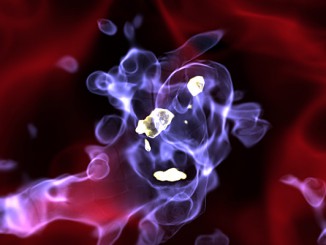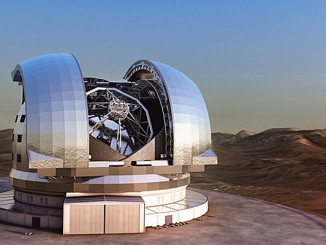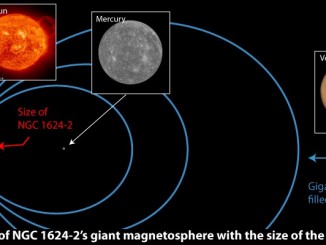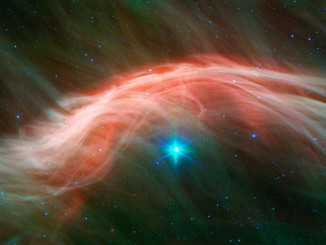
Archive


Modest-mass galaxy hosts oversized black hole: an evolutionary missing link?
The central supermassive black hole of a recently discovered galaxy called SAGE0536AGN is far larger than should be possible, according to current theories of galactic evolution. The galaxy was found by accident with NASA’s Spitzer space telescope and is thought to be at least 9 billion years old. Time will tell whether SAGE0536AGN really is an oddball, or simply the first in a new class of galaxies.

Messier 17 in Sagittarius: a cosmic rose with many names
This new image of the rose-coloured star forming region Messier 17 was captured by the Wide Field Imager on the MPG/ESO 2.2-metre telescope at ESO’s La Silla Observatory in Chile. It is one of the sharpest images showing the entire nebula and not only reveals its full size, but also retains fine detail throughout the cosmic landscape of gas clouds, dust and newborn stars.

Surprising chemistry seen in molecular rings around young star
Astronomers using the Atacama Large Millimeter/submillimetre Array (ALMA) have discovered two spectacular rings of molecules encircling the young, Sun-like star IM Lup. The rings are made up of one of the most common heavy ions in space — DCO+ (deuterium, carbon, oxygen). This chemistry reveals new insights into the conditions of the planet-forming disc surrounding this star.

“Sunset Peak Star Trail” by Chap Him Wong
This image was captured from Sunset Peak, Lantau Island, Hong Kong by astrophotographer Chap Him Wong. Above the peak covered with gold and silver grass, the tantalising sky reveals star trails and the Milky Way beyond — winning image of the People & Space category in the Insight Astronomy Photographer of the Year competition 2015.

Unlocking the secrets of the universe’s brightest galaxies
The brightest galaxies in the universe, known as submillimetre galaxies (SMGs), aren’t visible to the naked eye. But look through an infrared telescope, and they light up the sky. They are probably 12 or 13 billion years old, and what makes them so luminous is that they form stars very quickly — 1000 times faster than our Milky Way. Now researchers have the first viable model of the origins of SMGs.

UK scientists seal deal on European Extremely Large Telescope’s first-light spectrograph
UK researchers have just signed an agreement to lead one of the first instruments for what will become the World’s largest visible and infrared telescope, the European Extremely Large Telescope (E-ELT). The spectrograph, called HARMONI, will provide the European Southern Observatory’s telescope with a sensitivity that is up to hundreds of times better than any current telescope of its kind.

“The Magnificent Omega Centauri” by Ignacio Diaz Bobillo
Omega (ω) Centauri, or NGC 5139, is the brightest and largest globular cluster. This showpiece object of the southern sky is captured here in all its glory by astrophotographer Ignacio Diaz Bobillo — winning image of the Stars & Nebulae category in the Insight Astronomy Photographer of the Year competition 2015.

Hot, dense material surrounds O-type star with largest magnetic field known
O-type stars are the hottest and brightest stars known. NASA’s Chandra X-ray Observatory has revealed that the magnetic field at the surface of NGC 1624-2 is 20,000 times stronger than at the surface of our Sun. NGC 1624-2 contains a raging storm of extreme stellar winds and dense plasma that gobbles up X-rays before they can escape into space.

Radio telescopes could spot supersonic stars hidden in the galactic centre
The centre of our Milky Way galaxy is a mysterious place. Not only is it thousands of light-years away, it’s also cloaked in so much dust that most stars within are rendered invisible. Harvard researchers are proposing a new way to clear the fog and spot stars hiding there. They suggest looking for radio waves coming from supersonic stars.
